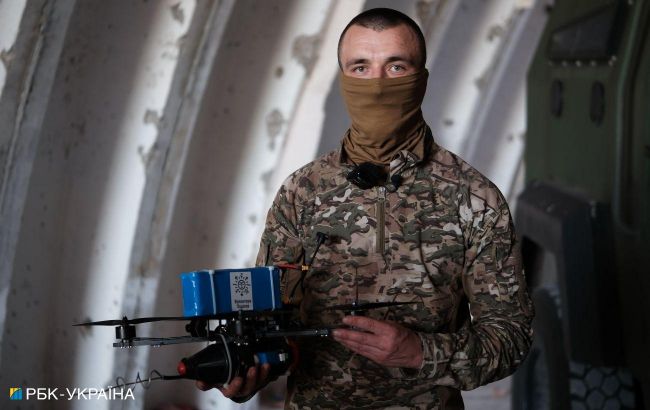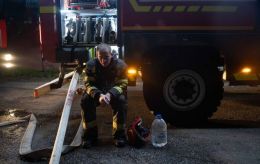Intelligence officer from Kabul-9 unit: We reach where enemy least expects
 Special unit officer with a call sign Deputat (All photos: Vitalii Nosach/RBC-Ukraine)
Special unit officer with a call sign Deputat (All photos: Vitalii Nosach/RBC-Ukraine)
The fighters of the special unit Kabul-9 of the Defense Intelligence of Ukraine (DIU) participate in many important operations to eliminate the enemy. Additionally, the intelligence officers regularly disrupt the enemy's plans by destroying its logistics and ammunition depots. In an interview with RBC-Ukraine, a special forces member with the call sign Deputat ("Deputy") told how Kabul-9 operates and what the fighters think about the Russians.
The Kabul-9 unit was formed at the beginning of Russia's full-scale invasion of Ukraine. It includes veterans of the special services and the Armed Forces of Ukraine. The special unit's fighters participated in repelling the Russian forces' advance on Kyiv, defending the capital, Hostomel, and Brovary.
After the Russians retreated from northern Ukraine, the unit was redeployed to the south. Also, the unit's mortar teams and sniper groups of DIU operated during the defense of Bakhmut
The intelligence unit has destroyed numerous pieces of armored vehicles, Russian equipment, and two Su-25 aircraft. Currently, the special forces of the unit are fighting on the Zaporizhzhia front near the village of Robotyne.
The senior intelligence officer of Kabul-9, with the call sign Deputat, was a deputy in local government in civilian life. With the onset of the full-scale war, he changed his business suit for a military uniform.

– It is known that your unit was formed from veterans. Can you tell us in general how Kabul-9 was formed and how its combat career began?
– The initiative to create the unit came from Kyrylo Budanov, the head of the DIU. The unit was formed from veterans of special services and motivated individuals with military experience. Many of our fighters are also from the Special Operations Forces.
Our main battles began in Hostomel, during the Kyiv campaign, and then the unit was redeployed to southern Ukraine in the spring of 2022. We have many specialists in narrow fields because the unit uses a variety of different types of equipment. For example, in Bakhmut, we stopped the Wagner Group and covered our comrades, using 120mm mortars.
– At the beginning of the full-scale war, the Kabul-9 fighters destroyed enemy Su-25 attack aircraft. Could you tell us how you managed to do that?
– Russian aircraft felt quite free in Ukrainian airspace, even flying over our roads. There were two such incidents. Our comrades acted decisively and destroyed the enemy equipment. Now the situation has changed; we don't even allow them close to the areas they used to fly into. In 2022, they felt free in the sky.
– There's a published list of equipment destroyed by your unit. Is this list comprehensive, or is it much larger?
– There is quite a lot of equipment, as there are a lot of operations involving FPV drones. We destroy a lot of enemy vehicles during one mission. This includes armored vehicles, armored personnel carriers, tanks, and unarmored vehicles. As there are no such intense actions and assaults in our area as, for example, in the Donbas or Kharkiv region, we are now actively fighting their logistics routes.
For example, Bukhanka (Soviet/Russian minibus - ed.). It may seem insignificant, but it transports ammunition, and personnel, and conducts rotations. If we destroy 3-4 of them in one area, it demoralizes the enemy because they understand they can't retrieve them; evacuation cannot happen. We've cut them off. So, we're currently focused on destroying their logistical chains. We've also destroyed a large number of trucks, KAMAZ vehicles, and Ural trucks. These are vehicles transporting ammunition, fuel, food, supplies, and personnel. It's a significant problem for them.
One of the activities of Kabul-9 is artillery guidance using our UAVs. For example, in our unit, we have the Leleka, which destroyed a TOR (anti-aircraft missile system). This is all done in collaboration with various units because we don't have direct means of attack like cannons. Therefore, we work in the interests of a brigade, artillery unit, or any other unit on the front lines. We search for targets and adjust their strikes.
– What operations do you consider the most successful throughout the history of your special unit?
– This is the Kharkiv offensive. The Kherson offensive was also successful. But it can hardly be called successful, because we suffered significant losses there... And, of course, the operation in Kyiv. Its success was partly because the Russians severely underestimated the Ukrainians. When the enemy expected to advance in three days, they encountered strong resistance, and the outcome favored us.
In the south, during the operation, the legendary 28th Brigade was holding the line. It was difficult for them because one brigade was holding a significant portion of the front. We helped them. Then the newly formed 65th Brigade appeared, but the 28th Brigade took the brunt of the Melitopol offensive. The main battles that took place in the south occurred in June of 2023.
But if we talk about the most difficult battles for our unit, it would be during the defense of Bahmut. The Wagner was storming the city, and gradually they began to capture it quarter by quarter. It was probably the most risky time for our unit. Their tactics were very specific because they had a huge manpower resource they didn't care about. They just threw a large number of soldiers at us, and by the most conservative estimates, they left 40,000 personnel under Bakhmut.

Their tactic was to overwhelm us with numbers, and from our side, there simply wasn't the opportunity to stop this flow. We would have suffered losses regardless of the proportion. Then, if you remember, Wagner hardly used any equipment in Bahmut. There were just many assault groups. And they pressed along the entire line. Wherever they found a weakness, they simply pushed with their assault groups. And that's how they succeeded.
– When you took Russians prisoner, were you able to communicate with them? What did they say?
– You see, the psychology of a prisoner, especially if he's part of Storm Z (units recruited from prisoners - ed.), is to justify himself. He immediately starts saying he's here by accident, that nobody ever shot at anything, they were brought here like kittens, thrown here, and that's it. We understand that these are tales for us, but the motivation, of course, for many of them, is money because they are recruited from depressed regions of Russia, so money motivates them to take any risk.
As far as I know, the contract fee was $7,000, now it's around $10,000. It's a one-time fee. For signing the contract, for taking this path. Of course, they are all promised that they will be on the fourth line, standing at the checkpoint, but in reality, they are sent to assault. And whether they want to or not, they have to fight. Look at the large number of suicides recorded among them during those assaults. These suicides have already been called Putin's kiss – someone with a gun, some with a grenade.
There's still a portion of the mobilized who haven't been demobilized yet, they are forced to follow all orders. By their nature, the Russians are punching bags, and no matter how they are positioned, they will go to the end. They will do it well. There won't be any rebellion; they will go to the end because their master said so.
– Now we see the escalation along the entire front line. There are battles both in the Kharkiv region and in Donbas. Is there a likelihood that they will reinforce the offensive in the Zaporizhzhia direction and try to seize territories here? What is the situation now?
– Recently, they even attempted to storm the area in the direction of Huliaipole using equipment. Of course, the situation is dire in the direction of Robotyne. There is regular utilization there; a T-55 tank and other equipment have been spotted. They use a lot of equipment.
There was even a case when they gained a foothold in one of the buildings in Robotyne and just went into hiding and waited for someone to replace them. They were brought there, and if they were shot on the way, they could be replaced with others, and sometimes they weren't replaced. That's the tactic. But now it's a scorched field there. In other words, Robotyne as a settlement simply doesn't exist. If someone crawls out of hiding there, they will be immediately spotted.
– Your group works with FPV drones. The biggest problem in this work is Russian EW systems. Are you currently managing to bypass them? What is the current specifics of drone kamikaze warfare?
– The FPV drone itself is not a ready-made solution. It's like a LEGO set that can be upgraded, changed, and reprogrammed to different frequencies. And the EW system is also evolving rapidly. They are spreading to wider ranges. And this competition is ongoing. We try to jam them, they try to jam us. We want to outsmart them, we have to come up with something else, and this is always happening. And a large number of EW systems, of course, are being reinforced in those directions where there were fewer of them.
Portable EW systems are more commonly used. If previously it was quite unusual to see EW systems on cars, now it is the number one necessity on the front lines. Several systems can be installed on a car. And of course, they evolve, we evolve. It's important who does it faster.

We rely more on kamikaze drones. For example, we have recorded results – hits 24 kilometers away from us. It's a place where the enemy can't even imagine that a drone could fly there. It's a serious threat to them. The army operates on discipline and systematic work. Certain logistic corridors are established – they will have replacements at a certain time, and something will be delivered to them at a certain time. And if these chains are disrupted, additional problems arise. It's additional evacuation, and the need to replace damaged transport.
These are serious inconveniences. And when this system is increasingly disrupted, it's a big discomfort for the enemy. So, the enemy infantryman, who was supposed to be at an observation post, doesn't know if he'll be replaced today if he'll get food today, or if ammunition will be delivered today.
– What are the main difficulties on the battlefield now? Does the enemy have any weaknesses?
– I think the biggest challenge for us is that the enemy learns from their mistakes and systematically corrects them. We see that happening. For example, the electronic warfare systems they install on vehicles. If it was easier to hit them before, it's not so easy now. They change their movement times, so 70-80% of their movement along the frontline now occurs during the night. The enemy understands the danger posed by FPV drones. But now we also have night vision cameras, and there are many nighttime strikes where the enemy has no chance to escape. They still need to carry out logistical tasks, and they're forced to take risks.

